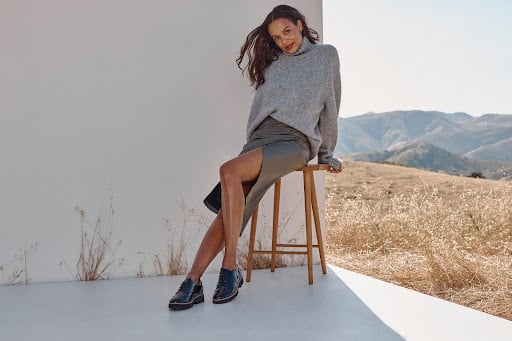
When crafting the perfect outfit, accessories matter. Just like picking out the perfect watch or tie, the way you lace your dress shoes can showcase your personal style and elevate your ensemble.
For a polished and sophisticated style, you can choose from a variety of popular dress shoe lacing patterns, including the classic straight bar and the elegant criss-cross technique. Today, we’re teaching you how to lace dress shoes with our step-by-step guide so you have the confidence you need to tie your style together, no matter the occasion.
Dress Shoe Lacing Patterns: What You Need to Know
Lacing patterns make it easy to change how your dress shoes look (or feel) without buying a brand-new pair. Easily interchangeable, you can change your laces and lacing technique as often as you’d like to match your ensemble or provide maximum comfort for your foot shape.
They also allow you to spice up your outfit with an accent color, and help to ensure you look clean and polished by replacing work or dirty laces.
Of course, you might be wondering how to tie dress shoes (which we’ll address below), but if you master the technique then you can add even more versatility to your wardrobe.
Mastering the Bar Lacing Technique
A classic look, the bar lacing technique involves your laces lying horizontally, straight across from eyelet to eyelet. This is a look that you can feature for both casual and formal events, meaning it’s great for going from a day at the office to an elegant dinner party.
Here’s a list of steps you can follow to master the bar lacing technique:
Step 1: Insert the Laces
Begin the bar lacing method by inserting one end of your shoelace into the bottom right eyelet from the outside of the shoe, and pulling towards you. Then, repeat this step with the other side of the shoelace, inserting it into the bottom left eyelet.
When you’re finished, the lace should lie flat across the bottom of the front of the shoe, with equal parts of the shoelace hanging on the right and left sides.
Step 2: Balance the Laces According to the Eyelets
If your dress shoe has an even number of eyelets, you can leave your shoelaces as they are, with an even amount of the lace remaining on each side.
Instead, if you have an odd number of eyelets, you’ll want to pull one side of the lace so that either the right or the left side is two inches longer than the other. This will come in handy as you continue this lacing technique.
Step 3: Continue Lacing Through the Eyelets
Now, you can continue lacing, feeding the laces through the eyelets. With an even number, you can start with either side of the lace, but if you have an odd number of eyelet pairs, begin lacing with the longer side.
From the underside of the top of the shoe, feed the lace through the next eyelet, directly above the previous ones. This means that instead of lacing diagonally, you’ll take the lace from the bottom left eyelet and feed it to the next eyelet directly above it on the left side.
Then, you can cross straight across the top of the shoe and create another lace bar by feeding the lace back through the adjacent eyelet on the opposite side.
Step 4: Move on to the Other Side of the Shoelace
Then, pick up the other side of the shoelace. Instead of repeating the previous step and pulling it through the second eyelet on the same side, you’ll pull it through the third eyelet, allowing you to prepare to create a third horizontal bar with your laces.
From the underside of the shoe, pull the lace through the third eyelet on the same side, and then pull it across the top of the shoe, and through the third eyelet on the opposite side. You should now have three bars of laces.
Step 5: Repeat the Previous Steps
Once you’ve started to understand the technique, you can repeat steps three and four until both ends of the shoelace reach the top eyelets.
With an odd number of eyelet pairs, you’ll want to cross the longer end of the shoelace diagonally and pull it through the top eyelet on the opposite side to finish up the bars. You can skip this step if your dress shoes have an even number of eyelet pairs.
Adding a Touch of Elegance: Cross-Lace Method
For another elegant lacing approach, you can also opt for a cross-lace method, which allows you to create diagonal lines that overlap down the front of your dress shoe. When lacing dress shoes with the cross-lace method, follow the steps below:
Step 1: Create a Bar in the Bottom Eyelet
You can begin this technique the same way you would with the bar method—by creating a bar across the bottom-row eyelets.
However, with this method, you can start from the inside of the eyelets going out, or from the outside of the eyelets pulling the laces inward. Regardless of which approach you choose, try to have an even length of the shoelace on both sides of the shoe.
Step 2: Cross Your Lace Diagonally
Next, you’ll want to pull one side of the shoelace across the centerline of the shoe diagonally, inserting it into the eyelet that’s one above and one across from the location of the shoelace. Repeat this step with the other end of the shoelace to create two diagonal lines with your laces.
Step 3: Continue this Pattern
You can continue this diagonal lacing pattern until you get to the final top eyelet pair. If the first bar of your laces is under the eyelets, you’ll want to pull the laces above and through the eyelets when crossing diagonally.
Alternatively, if the first bar is above the laces, you’ll want to pull them under and through the eyelets. Whichever method you choose, make sure to be consistent.
Dress Shoes for Different Occasions and Styles
When you’re trying to decide on a dress shoe for your next interview, formal dinner, or day in the office, there are a variety of styles, materials, and colors for you to consider. Here’s a look at some popular dress shoes and how you can lace them depending on the occasion:
The Oxford
Oxfords—also called the Balmoral dress shoe—are stylish and comfortable, and are easy to dress up or dress down, making them one of the most versatile dress shoe options. They come in a variety of styles, including:
- Cap toe oxfords
- Wingtip oxfords
- One-piece oxfords
- Plain toe oxfords
This iconic shoe gained popularity in the 1800s amongst college students at Oxford University, where some think it got its name.1 Others claim it’s named after the Balmoral castle in Scotland.1 Regardless of its origins, Oxfords remains a popular, timeless style, often featuring bar-laced shoelaces down their front as seen in the Alfina Oxford.
The Derby
Another eye-catching dress shoe is the Derby—also called the Blucher or the Gibson—which initially caught on around the late 1800s and has only grown in popularity since.2 This shoe features similar details as the Oxford, although they have distinctly unique features that make them another go-to choice amongst dress shoe lovers.
The key difference between these two pairs is that the Derby’s lacing attaches to the top of the shoe vamp, which as tying dress shoes pertains, is a standout composition. This lacing structure also creates a wider fit, which can make Derby’s a more comfortable dress shoe option depending on the shape of your feet.
A bit more casual than Oxfords, you can typically pair the Derby with a khaki or blazer. While you may not wear them with a formal suit, they make the perfect addition to your dinner attire or allow you to elevate your ensemble when you head to work.
Achieving Optimal Comfort with Proper Lacing
Besides showcasing your personal style, lacing techniques can also help you enhance the support of your footwear, allowing you to achieve optimal comfort with your dress shoes. Some dress shoes—like the Derby—allow for a wider fit, which can help maximize comfort when laced with the right technique.
If you’re looking for more flexibility from your dress shoe, consider a cross-lace method, allowing you to loosen and tighten them with ease.
Alternatively, if you find a shoe with a perfect fit and want to make sure it stays firmly in place, you may want to opt for a lacing technique like the bar method.
Level-Up Your Lacing Method with Vionic
Whether you opt for the sleek and stylish bar lace technique or the classic cross-lace method, you can tie your aesthetic together with the color and style of laces. Whatever the occasion, your laces can make a statement, highlight your fashion sense, and prioritize your foot health.
At Vionic, we take your comfort seriously.
That’s why we offer a variety of dress shoes and other footwear options with cutting-edge Vio Motion Technology, designed to give your feet the comfort you deserve without sacrificing the style you love. And along with comfortable designs, we’re always going to make space to teach you how to lace up dress shoes.
Sources:
- Collins, Jack. “The Oxford Shoe Guide.” Gentleman’s Gazette. https://www.gentlemansgazette.com/oxford-shoes-guide/
- “Derby Shoes for Men.” Reead. https://www.reead.com/en/derby-shoes-men/


Leave a Reply